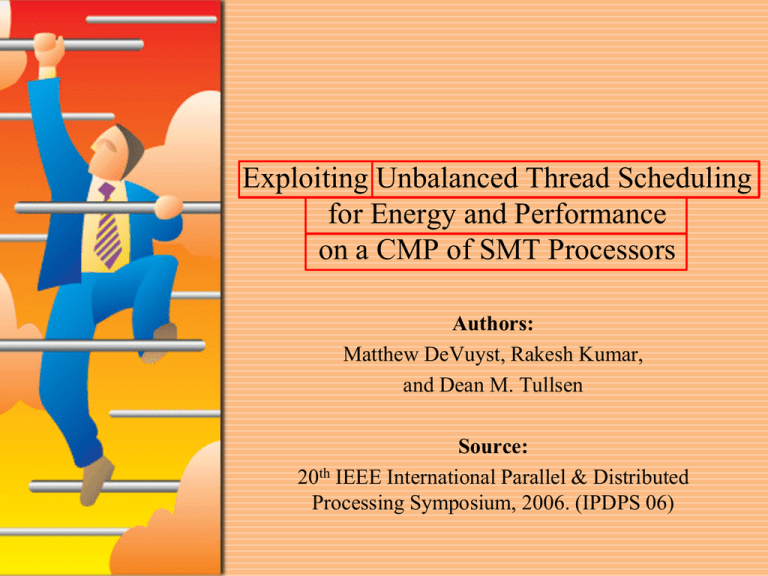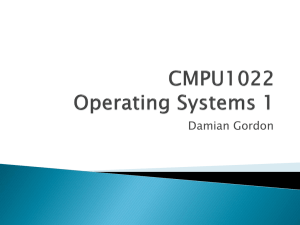Exploiting Unbalanced Thread Scheduling for Energy and Performance
advertisement

Exploiting Unbalanced Thread Scheduling for Energy and Performance on a CMP of SMT Processors Authors: Matthew DeVuyst, Rakesh Kumar, and Dean M. Tullsen Source: 20th IEEE International Parallel & Distributed Processing Symposium, 2006. (IPDPS 06) Outline • Introduction • Architecture • Scheduling Policies – Sampling-based Policies – Electron Policies • Experimental Methodology • Analysis and Results • Conclusions Outline • Introduction • Architecture • Scheduling Policies – Sampling-based Policies – Electron Policies • Experimental Methodology • Analysis and Results • Conclusions Introduction • Given a set of applications and a set of multithreaded cores, the space of possible schedules of threads to cores can be enormous. – which threads, and how many, are co-scheduled on cores. App. 1 App. 2 App. 3 Core 1 Core 2 App. 4 Core 3 App. 5 Core 4 App. 6 App. 7 Introduction (cont.) • Conventional multiprocessor schedulers, applied to this architecture, will always seek to balance the number of threads on each core. • This research demonstrates that such an approach eliminates one of the big advantages of this architecture – the ability to use unbalanced schedules to allocate the right amount of execution resources to each thread. Introduction (cont.) App. 1 Core 1 App. 2 App. 3 Core 2Power App. 1 Core 1 App. 2 App. 3 Core 2 gating Low marginal performance Less marginal power High marginal performance High marginal power Introduction (cont.) • This paper examines system-level thread scheduling policies for a chip multithreaded architecture. • Particular attention is paid to enabling performance and energy efficiency through unbalanced schedules. • These schedules give the system the ability – Cluster threads that have low execution demands – Amortize the power cost of using a core Outline • Introduction • Architecture • Scheduling Policies – Sampling-based Policies – Electron Policies • Experimental Methodology • Analysis and Results • Conclusions Architecture • The architecture is a chip multiprocessor consisting of – – – – – – – 4 homogeneous simultaneous multithreaded cores 4 contexts per core, for a total of 16 contexts in the system Each SMT core is out-of-order Implemented in the 0.1μm process Shared L2 and L3 caches Each core has its own L1 data cache and L1 instruction cache The implementation is assumed to be at 2.1 GHz and latencies are determined accordingly Core 1 Core 2 Core 3 Core 5 Core 4 Core 6 Core 7 Core 9 Core 8 Core 10 Core 11 Core 13 Core 12 Core 14 Core 15 Core 16 Architecture (cont.) • When a thread migrates to another core – The dirty data in the L1 data cache of the core it was previously running on will be written to both the L1 cache of the core on which the thread is now running and the shared L2 cache. • In this work, we assume that unused cores are completely powered down, rather than left idle. – unused cores suffer no static leakage or dynamic switching power – it takes 30μs to turn on or off a core, include plenty of time for dirty data to be flushed from the caches, as well Architecture (cont.) Outline • Introduction • Architecture • Scheduling Policies – Sampling-based Policies – Electron Policies • Experimental Methodology • Analysis and Results • Conclusions Scheduling Policies • We assume an operating system level thread scheduler that makes global (CMP-wide) scheduling decisions. • The processor typically makes scheduling decisions based on sampled data of processor power and performance. – processor power and performance can be estimated by reading counter registers that are already found in most modern processors – new samples are collected and new scheduling decisions can be made as often as every operating system timer interrupt or when the mix of jobs changes Scheduling Policies (cont.) • Assume all jobs have equal priority. • The scheduling policies we evaluate come in two broad categories: – Sampling-based policies – Electron policies Outline • Introduction • Architecture • Scheduling Policies – Sampling-based Policies – Electron Policies • Experimental Methodology • Analysis and Results • Conclusions Sampling-based policies • The sampling-based policies work in a series of alternating temporal phases: – A sampling phase – A steady phase • During the sampling phase, a number of different schedules are tried; at the end of the sampling phase the sample schedule with the best metric value is chosen as the schedule to be in effect throughout the steady phase. Sampling-based policies (cont.) • Consider the following sampling-based scheduling policies – – – – – – Balanced Symbiosis Symbiosis Balanced Random Prefer Last – Numbers Prefer Last – Swap Prefer Last – Move • All these policies are evaluated assuming that any unused cores are power gated. Sampling-based policies (cont.) • We consider four system-level objective functions in this paper – Performance • The metric for performance is calculated weighted speedup (CWS). • IPC for that sample CWS average IPC for all samples – Power • The sum of the power of all the cores plus the power of the shared structures. – Energy • Energy Power Per Cycle IPC – Energy Delay Product (EDC) • EDP Power Per Cycle IPC 2 Outline • Introduction • Architecture • Scheduling Policies – Sampling-based Policies – Electron Policies • Experimental Methodology • Analysis and Results • Conclusions Electron Policies • The policies in the previous section rely on sampling for intelligent scheduling. – However, such policies become less effective as the search space expands. • Rather than sampling, the electron policies rely on more explicit evidence – That a particular core is over-scheduled, under-scheduled, or just poorly scheduled. Electron Policies (cont.) • Cores will attract threads that fill a void and repel threads when contention is high. • Threads will move around each interval to create a better fit. The schedule naturally adapts as threads enter new phases of execution. Electron Policies (cont.) • Consider the following electron policies customized for each metric – Electron – Performance – Electron – Energy – Electron – EDP • For the electron policies, the duration of a period is moderately long. If a new schedule results in a core being left idle, that core is powered down immediately. Electron Policies (cont.) • If the new schedule calls for cores to be either powered on or powered off, the scheduler does not sample any performance or power counters during the transition. • Note that electron schedulers run into the risk of continuing to alternate among two schedules. – To help avoid such situations, history information has been incorporated into the scheduling policy decisions. – The electron scheduling policies will be able to adapt to workload phase changes. Outline • Introduction • Architecture • Scheduling Policies – Sampling-based Policies – Electron Policies • Experimental Methodology • Analysis and Results • Conclusions Experimental Methodology • Our thread scheduler is assumed to be a part of the operating system. New samples are collected and new scheduling decisions can be made at every operating system time-slice interval. • We have assumed an operating system time-slice of a quarter million cycles. This time-slice is artificially short to keep our simulations from taking too long. Experimental Methodology (cont.) • Twelve benchmarks from the SPEC 2000 benchmark suite were chosen to construct workloads for our evaluation. – Each benchmark was fast-forwarded for 2 billion instructions before detailed simulation. Experimental Methodology (cont.) • All our simulations are done using a chip-multi-threaded multiprocessor derivative of SMTSIM. • Appropriate modifications were done to simulate the effect of OS-level scheduling as well as the availability of hardware counters. • To gather power statistics we integrated a modified version of Wattch into our simulator. Outline • Introduction • Architecture • Scheduling Policies – Sampling-based Policies – Electron Policies • Experimental Methodology • Analysis and Results • Conclusions Analysis and Results • The marginal performance achieved by using an additional core in a CMP of SMTs is typically higher than the marginal performance improvement from using an additional SMT context on the same core. • On the other hand, the converse is true for energy. That is, energy efficiency increases with the number of contexts in operation, so we tend to aggregate threads when scheduling for energy Core 1 Core 2 Core 5 Core 3 Core 4 Core 6 Core 7 Core 8 Analysis and Results (cont.) • Scheduling for a CMP of SMTs such that both power and performance are optimized, then, requires a careful balance between these two competing objectives. Analysis and Results (cont.) • We perform all our evaluations in this section using the energy-delay product (EDP) metric. • EDP recognizes the importance of both power and performance and is used widely as an important objective function for desktop as well as server processors. Unbalanced Scheduling • Static Ideal – That allows unbalanced scheduling against the best static scheduling policies that are constrained to be balanced. • Static Balanced – Ensures that each core runs the same number of threads and, hence, is similar to the traditional load-balancing schedulers. • Cluster Balanced – Ensures that only as many cores as necessary to run a given number of threads are kept on and the rest are power gated; among the active cores, each core runs the same number of threads. Unbalanced Scheduling (cont.) 6.6% 12% Unbalanced Scheduling (cont.) 75% 62.5% Unbalanced Scheduling (cont.) • The advantages due to unbalanced scheduling depend on the characteristics of the workload. – Benchmarks gcc and gzip are averse to running with other applications due to high ICache working set sizes and high core utilization, respectively. – Balanced scheduling policies force these applications to be coscheduled with some other thread on the same core resulting in a significant performance hit. – However, Static Ideal allows these applications to be on a core by themselves resulting in high overall efficiency. Exploring the Search Space through Directed Sampling 7.8% 2.3% Exploring the Search Space through Directed Sampling (cont.) 89% 91% 59% 90% Exploring the Search Space through Directed Sampling (cont.) 7.8% 5.9% 1.9% 2.3% Non-sampling Strategies 2.4X 2X Non-sampling Strategies (cont.) 99% 83% 100% Conclusions • A traditional multiprocessor scheduler will not identify the best schedules. A good scheduler must be able to explore both balanced and unbalanced schedules. • This paper proposes several operating system level thread scheduling policies for both performance and energy are first-class concerns, and that adapt dynamically to the current program behavior. • We show gains, versus a random scheduler that always uses balanced schedules, of 6-11% in energy-delay product.






